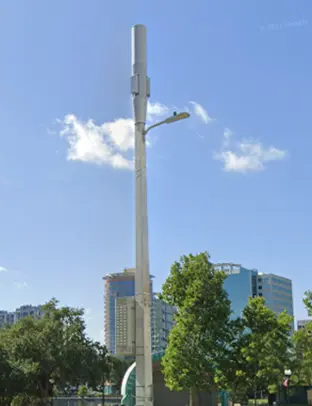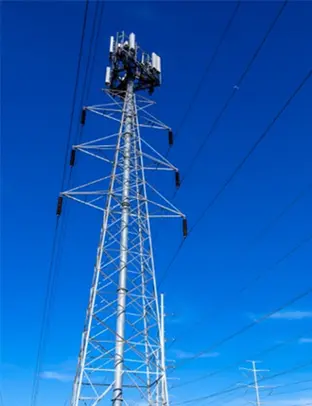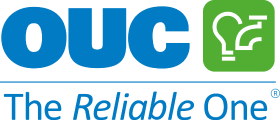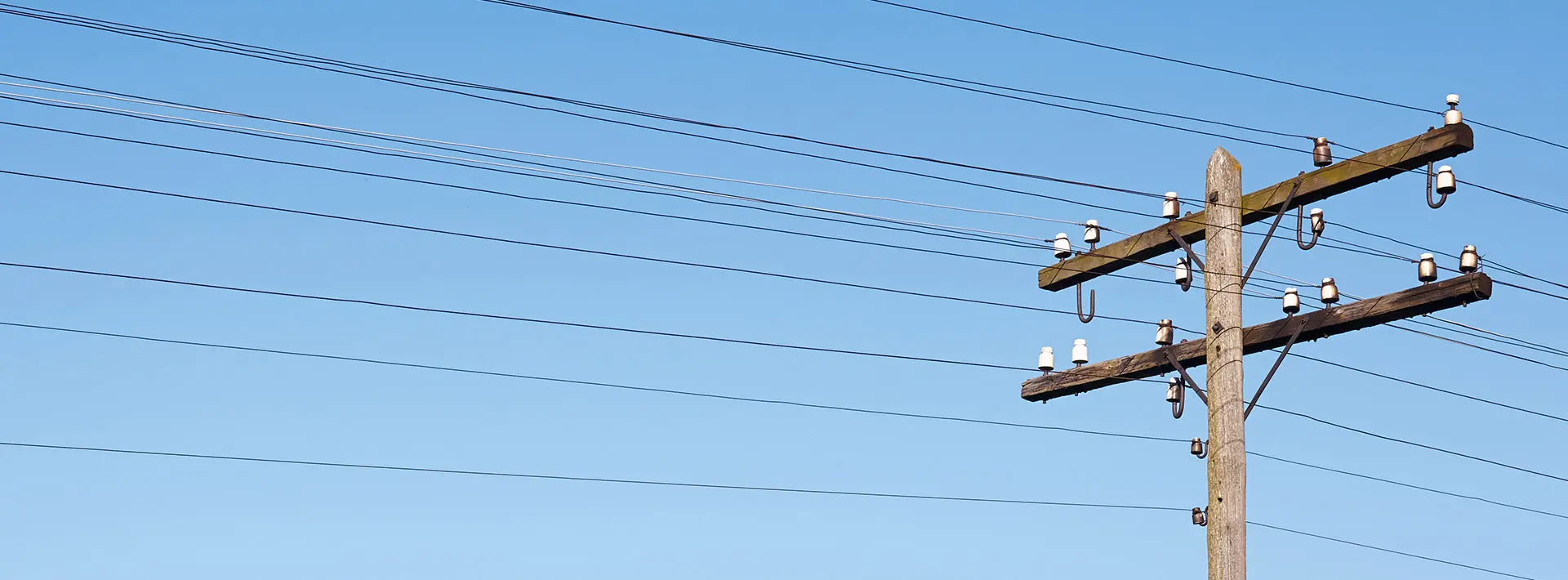Explore the Benefits
Premium locations for integration
Experienced & knowledgeable staff
Streamlined processes from start to finish
Vertical Attachment Types
Take advantage of OUC’s vertical real estate to meet your project needs.

Wireline/Fiber Pole Attachments
Per the FCC, the term “pole attachment” means any attachment by a cable television system or provider of telecommunications service to a pole, duct, conduit, or right-of-way owned or controlled by a utility.
OUC considers attachments to be, but not limited to any wire, line or related apparatus of the Licensee attached to a pole, including but not limited to, cables, service drops, power supplies, amplifiers, pedestals, bonding wires, overlashings, guy wires and anchors required to support unbalanced loads.
Who can apply for this type of attachment?
Any cable television system or provider of telecommunications service can make an application for an attachment to an OUC owned pole. However, they must have a standard pole attachment contract signed with OUC.
What are the steps for a wireline pole attachment?
- Work with OUC’s contracts team within the operations administration area of OUC to execute an agreement.
- The contracts team will facilitate a kick-off meeting where the attacher and OUC’s engineering team can meet and ask any attachment-related questions prior to submitting applications.
- The next step is to submit an application for the specific poles that your organization wants to attach. The application should be submitted to [email protected].
- A member of the contracts team will reach out to provide application fee payment instructions. Once the application fee is received, the application will be forwarded to OUC’s engineering team to evaluate the application.
- The application will be returned to the applicant signed by OUC’s engineering representative. If the application is deemed approved, that is considered the application to install applicant’s facilities on the pole.
Wireless/Small Cell Pole Attachments
Per the FCC, the term “pole attachment” means any attachment by a cable television system or provider of telecommunications service to a pole, duct, conduit, or right-of-way owned or controlled by a utility.
OUC considers wireless attachments to be, but not limited to, attachments that transmit information over-the-air (OTA). Wireless equipment includes an antenna, transmitter, receiver or associated equipment that is used for the transmission or reception of radiofrequency (“RF”) signals. A small cell attachment typically involves: an antenna (mounted at the top of the pole or on the strand) a power source and fiber.

Who can apply for this type of attachment?
Any cable television system or provider of telecommunications service can make an application for an attachment to an OUC owned pole. However, they must have a standard pole attachment contract signed with OUC.
what are the Steps for a wireline pole attachment?
- Work with OUC’s contracts team within the operations administration area of OUC to execute an agreement.
- The contracts team will facilitate a kick-off meeting where the attacher and OUC’s engineering team can meet and ask any attachment-related questions prior to submitting applications.
- The next step is to submit an application for the specific poles that your organization wants to attach. The application should be submitted to [email protected]
- A member of the contracts team will reach out to provide application fee payment instructions. Once the application fee is received, the application will be forwarded to OUC’s engineering team to evaluate the application.
- The application will be returned to the applicant signed by OUC’s engineering representative. If the application is deemed approved, that is considered the application to install applicant’s facilities on the pole.

Tower Attachments
A macrosite is a cell in a mobile phone network that provides radio coverage served by a high-power cell site (transmission, communication or water tower). Generally, a macrosite provide coverage larger than a small cell or wireless site.
Who can apply for this type of attachment?
Any cell provider can make an application for an attachment to an OUC owned tower; however, they must have a Master License Agreement signed with OUC.
What are the steps for a wireline pole attachment?
- Work with OUC’s contracts team within the operations administration area of OUC to execute an agreement.
- The contracts team will facilitate a kick-off meeting where the attacher and OUC’s tower real estate consultant can meet and ask any attachment-related questions prior to submitting applications.
- The next step is to submit an application for the specific towers that your organization wants to attach.
- A member of the consultant team will reach out to provide application fee payment instructions. Once the application fee is received, the consultant will gather all related documents such as CDs, drawings, and any other documents for OUC to evaluate, and a cost letter will be sent to the carrier. Subsequently, the application will be forwarded to OUC’s engineering team to evaluate the application.
- The following checklist will be used:
- Approve Initial Application
- Approve any stand-by or outages needed
- Review power equipment CD’s
- Site Plans
- Property survey
- Mount analysis
- Wind load analysis
- Approve Notice to Proceed (NTP)
- Generator/Land Space Requests
- Tower Modifications
- Final Close-Out Package
- The carrier will work with the consultant and OUC’s contracts team to develop a Site License Agreement (SLA). Once approved and executed by both parties, the SLA shall be in force and the due diligence period will begin.
Banner Attachments: Orlando’s Main Street Districts
The City of Orlando adopted amendments to its sign code (Chapter 64) to allow certain designated, commercial districts as provided in the City’s Ordinance Number 2010-1 and Ordinance Number 2013-41 the right to display City approved banners on OUC poles and free-hanging bibs on said banners for the purpose of promoting, defining and identifying commercial shopping entities within the given Districts and promoting certain events of public interest.

Who can apply for banner attachments?
Currently, the following districts are part of OUC’s Banner Agreement Program:
- Curry Ford West
- Ivanhoe
- Milk District
- College Park
- Gateway Orlando
- SoDo
- Audubon Park Mills 50
What are the Steps for a banner pole attachment?
- Work with OUC’s contracts team within the operations administration area of OUC to execute an agreement.
- The contracts team will facilitate a kick-off meeting where the District and OUC’s engineering team can meet and ask any attachment-related questions prior to submitting applications.
- Please download OUC’s Main Street Banner Procedures document and follow the instructions described within.
Ready to Get Started?
Our streamlined application process can help you meet your project deadlines.
Pole Attachments – FAQs
What do I need to begin the process?
All attachments require a contract, and all requesters need to apply for a permit. Please fill out the joint use contact form to initiate the process.
How much time do I have to attach after approval?
You have 90 days to complete this work.
Can I attach more than one item to the same pole?
Yes, if space is available.
Is there a certain height that is required?
We require 18-22 ft in communication space. Please see the attachment specifications for more details.
Can the streetlight be adjusted to attach at a certain height?
Please fill out the joint use contact form to speak with us directly.
Pole Attachment Terminology
View the complete List of Pole Attachment Terminology
Abandoned Attachment – Attachment for which attachment fees have not been paid and/or attachment to which an Attacher has been unresponsive to OUC’s inquiries or communications for more than six (6) months.
Anchor – A device supporting and holding in place conductors terminated at a pole or structure buried and attached to the pole by way of a guy wire to counteract the mechanical forces of these conductors.
Application for Temporary Construction Permit – OUC form used by potential Pole user to provide proposed aerial and wireless design and construction data to OUC to request Pole attachments.
Attacher – Provider of cable television and/or telecommunications services to which OUC has granted certain non-exclusive rights to use its Poles, pursuant to Section 224 of the Communications Act, as amended, other applicable law, and the parties’ Pole Attachment Agreement.
Authorized Attachment – Attachment that has been licensed through the Application for Temporary Construction Permit Process.
As-Built Construction – An Attacher’s actual aerial cable installations on OUC’s Poles, based on an originally submitted Application for Temporary Construction Permit for Pole Attachments, and any necessary design modifications and field changes made by the Attacher or requested by OUC during actual construction.
Boxed-In Pole – A pole with cable attachments installed on both the street side and the opposite side of a utility pole obstructing safe pole access and either routine or emergency pole replacement.
Cable Tagging – Method for the physical identification in the field of an attaching company’s aerial cable plant attached to OUC’s poles.
Cable Television System Attachments – Any fiber optic cable, coaxial cable, the cable and wires connected to such fiber optic cable and coaxial cable, and any and all supporting cable used by cable television operators providing only cable television services (“Cable Attachments”), as may be more fully described in the Guidelines.
Communication Service Drop – Communications cable from Attacher’s existing attachment to a new customer’s premises for the sole purpose of providing service to the new customer.
Communications Space – The lowest zone on a Pole, located immediately below the Communications Workers’ Safety Zone. The Communications Space is used primarily for the placement of cable television, broadband, fiber, and telephone wires used to deliver communications services.
Communication Workers Safety Zone – The safety zone, also called the “neutral” space, is the space between the lowest supply conductor or equipment and the highest communication cables or equipment. Spacing requirements for Communication Workers Safety Zone and other workers are specified by the NESC.
Conduit Riser – PVC tubing used to protect cable/fiber facilities that are attached to a Pole via Stand-Off Brackets that transitions facilities from underground to overhead.
DAS/SMALL CELL – A Distributed Antenna System (DAS) is a network of spatially separated antenna nodes connected to a common source via a fiber connection that provides wireless service supported by radio and battery back-up equipment.
Distribution System – The portion of an electric power system that distributes electricity to consumers from a bulk power location such as a substation.
Electrical Supply Zone – (see also Supply Space) the upper portion of a Pole, used for electric lines and other electric supply equipment, located above the Communications Workers Safety Zone, that is reserved to support electric distribution equipment.
Electrical Ground – A conducting connection by which an electric circuit, or equipment, is connected to the earth or some conducting body that serves in place of the earth.
Federal Communications Commission (FCC) – The federal Government agency responsible for implementing and enforcing the pole access requirements of Section 224 of the Communications Act as amended.
Foreign Pole – A utility pole that is not owned by OUC.
Ground Furniture – The electronic and electric hardware used to support wireless antenna(s) located separate from the Node Pole, typically located at the meter service pole.
Ground Rod – A large conductor attached to one side of the power supply that serves as the common return path for current from many different components in the circuit.
Grounding System – A power system providing for a common return path (to earth) for electrical current and for an appropriate current-carrying capability for absorbing an excess amount of current.
Guy Wire – Also known as strand, messenger, support wire, structure cable, or guy, a guy wire is designed to offset the lateral pull of the electrical wires and/or communications cable attachments.
Horizontal Extension Arm – A bracket extension arm attached at the Pole for the purpose of suspending cables or conductors at a distance from a pole.
Irregular Plant Conditions (IPCs) – Conditions associated with the Attacher’s facilities that OUC has determined adversely impact the safety and reliability of its electric distribution network.
Make-Ready – All work on an existing pole, including but not limited to such work required to rearrange and/or relocate existing attachments by OUC and/or third parties, and to correct any existing safety violations, that OUC may deem necessary pre-installation to ensure that any Pole for which Attacher has requested access is safe, reliable, and in suitable condition to support Attacher’s proposed Attachment.
Mid-Span Clearance – The required NESC vertical separation between power and communications conductors midway between two distribution poles. Mid-span clearance is the controlling factor in determining NESC clearance between power and communication lines.
National Electrical Safety Code (NESC) – The collaborative national standard of the Institute of Electrical and Electronics Engineers, Inc. (IEEE) and the American National Standards Institute (ANSI), providing for the safeguarding of persons from hazards arising from the installation, operation or maintenance of: (1) conductors and equipment in electric supply stations; and (2) overhead and underground electrical supply and communication lines and equipment, as may be amended from time to time.
Node Pole – Distribution Pole used to accommodate communications hardware (DAS or Small Cell Wireless Technology) that receives and transmits data does not include Ground Furniture.
Neutral – The conductor used to carry an unbalanced current. In single-phase systems, the conductor is used for a return current path.
Overlash(ing) – A specific method of attaching multiple communications cables on a single supporting strand, as further described in the FCC’s orders.
Pole – OUC’s Poles supporting electrical conductors of less than 69 kV, not including Transmission-only poles, dedicated metal poles, street light poles, and all other such special purpose poles or pole lines of non-standard design that do not support OUC’s electric distribution system.
Pole Attachment Agreement – Agreement executed by OUC and Attacher setting forth the terms and conditions pursuant to which Attacher may obtain access to OUC’s Poles, the applicable pole attachment rate(s) or rate formula(s), and the process whereby Attacher may obtain a Site License to use any individual OUC Pole.
Pole-Top Zone – Pole space located at the top of the pole.
Post-Installation Inspection – Inspection performed by OUC to ensure that the Attacher’s installation conforms to the design data approved in the Attacher’s Application for Temporary Construction Permit, and fully complies with the NESC, these Guidelines, and applicable regulations, codes, and laws.
Primary – A primary voltage distribution circuit delivering electric power through electrically charged conductors usually considered to be between a substation or point of supply and the distribution transformers.
Public Safety Department – OUC group responsible for promoting electric safety and educating the general public about the dangers of electricity.
Regulator – A device used to control (increase and decrease) the voltage of a circuit.
Route Map – Attacher’s map showing the intended aerial cable route using individual Poles.
Service Standards – OUC’s electric service standard practices compiled for the benefit and guidance of customers, contractors, electricians, architects, and engineers.
Single Phase – The distribution of electric power using a system in which the voltage is taken from one phase of a Three-Phase source.
Site License (SL) – OUC map document authorizing an Attacher’s non-exclusive right of attachment and ongoing use of specific OUC Poles as indicated thereon, and as the OUC and Attacher may amend from, time to time.
Stand-Off Bracket – 9-to-10-inch hardware bracket used to extend Conduit Risers away from Poles to provide safer climbing space.
Supply Space – (see also Electrical Supply Zone) the upper portion of a distribution pole located above the Communications Workers Safety Zone, used to support electric cables and other electric equipment, such as Transformers and capacitors, used for electric distribution. Only OUC-authorized electrical workers are allowed to work in or above the Supply Space.
Telecommunications Attachments – Any fiber optic cable, coaxial cable, the cable and wires connected to such fiber optic cable and coaxial cable, and any and all supporting cable used to provide Telecommunications Service as defined in Section 153(51) of the Communications Act of 1934, as amended, (“Act”), including without limitation, Broadband Internet Access Service, as defined in the FCC’s rules, or any combination of cable television service and/or telecommunications service with any other service not otherwise classified by the FCC (“Commingled Service”), including but not limited to Voice over Internet Protocol (“VoIP”) (“Telecommunications Attachments”).
Temporary Construction Permit (TCP) – OUC map document designating the Poles on which an Attacher has been authorized to place attachments, authorizing such Attacher to proceed with the specific installations approved by OUC, as requested in Attacher’s Application.
Three-Phase – A circuit consisting of three conductors where the current and voltage in each conductor (phase) is 120° out of phase with each other phase.
Three-Phase Major Underground (MUG) Terminal Pole – also known as a “dip pole,” is a medium voltage, three-phase, coppered-out switch that terminates at the pothead, which is used to transition between three-phase medium voltage overhead lines and three-phase underground medium voltage cable that either continues to feed the circuit or a three-phase underground Transformer.
Transformer – An electromagnetic device used to change the voltage in an alternating current electrical circuit.
Transmission – Normally, the highest voltage network of an electric utility system, that carries power over the longest distances, typically operating at voltages of 69 kV (69,000 volts) or greater.
U-Guard – U-shaped cover molding designed to protect communications cable facilities is located where communications circuits lead from underground to overhead.
Unauthorized Attachment– Any attachment that has not been licensed through the Application for OUC Distribution Pole Attachment process (Section 6).
Unusable Space – The space on the pole below the applicable minimum clearance requirement as defined by federal, state, or local regulations.
Wireless Telecommunications Attachments – Antennas and support equipment including but not limited to batteries, conduits, and boxes for power supply and other purposes, support mounts and structures, radio access nodes, accessory equipment (including associated hardware), cables and wires connecting antennas to accessory equipment on the same Pole, electronic equipment shelters and all property within such shelters, pedestals supporting equipment cabinets or panels, and other necessary communications equipment (located at the Ground Furniture) (collectively, “Wireless Telecommunications Attachments”) used to provide Telecommunications Service, as defined in Section 153(51) of the Communications Act of 1934, as amended (“Act”).
Transmission Towers & Substations – FAQs
Can contractors place a construction lien on OUC facilities?
OUC property/facilities cannot be liened since OUC is a municipal entity.
Who applies for the permit to begin construction?
The contractor performing the work must apply, not OUC.
What happens if I request a standby and my subcontractor doesn’t show up?
You will be billed for the standby time, whether or not you or your contractor show up.
Do I need an easement to run conduits to the OUC leased ground space area?
Where OUC is not the underlying property owner, yes, some type of arrangement will be needed with that property owner, with OUC’s approval that such an agreement does not interfere with OUC’s rights. On OUC fee-owned property, no, OUC allows for this.
Is OUC required to lease aerial tower space to companies requesting an attachment?
No. OUC’s primary function is a utility, not a vertical real estate company.
Is the structural requirement necessary for any change in attachments?
Yes, a structural conditional assessment is required for any change in attachments to the OUC structure.
What needs to be included with a structural conditional assessment?
An assessment should typically include the following items:
- Plans showing existing and proposed facilities, with a surveyed map showing the existing ground lease area.
- A copy of the current license agreement.
- Condition assessment of the foundation
- Soil borings
- Structure/tower structural analysis, with the largest wire size used by OUC shown in all conductor positions
- Typical wind loading to 120 mph (with 1.2 safety factor) showing the differences between the existing state and the proposed
- Tower mapping conditional assessment
In some cases, the structural analysis will be required to be studied with the existing AND proposed facilities attached.
Do I need to get OUC approval to modify the types of equipment in my ground leased area?
No, as long as you are able to keep your existing and proposed equipment all within the approved leased area. OUC does encourage you to communicate any changes to your facilities with the OUC contracts group.
What deliverables are required upon completion of any work on an OUC structure or property?
A construction close-out package from the inspecting entity. As-built survey of the immediate property showing the ground lease area, and the facilities within it. As-built information showing any/all attachments to the OUC structure.
What is the maximum percent loading of a structure, or one of its components, allowed by OUC?
Although industry practices allow for structural components to be loaded to 105%, OUC reserves all structure capabilities above 95% for its own usage. Any component showing 95% or greater shall be replaced with an appropriately sized piece to bring the loading of that component below the 95% value. OUC reserves the right to require the replacement of the entire structure if it deems that replacement is the best course of structural reliability.

